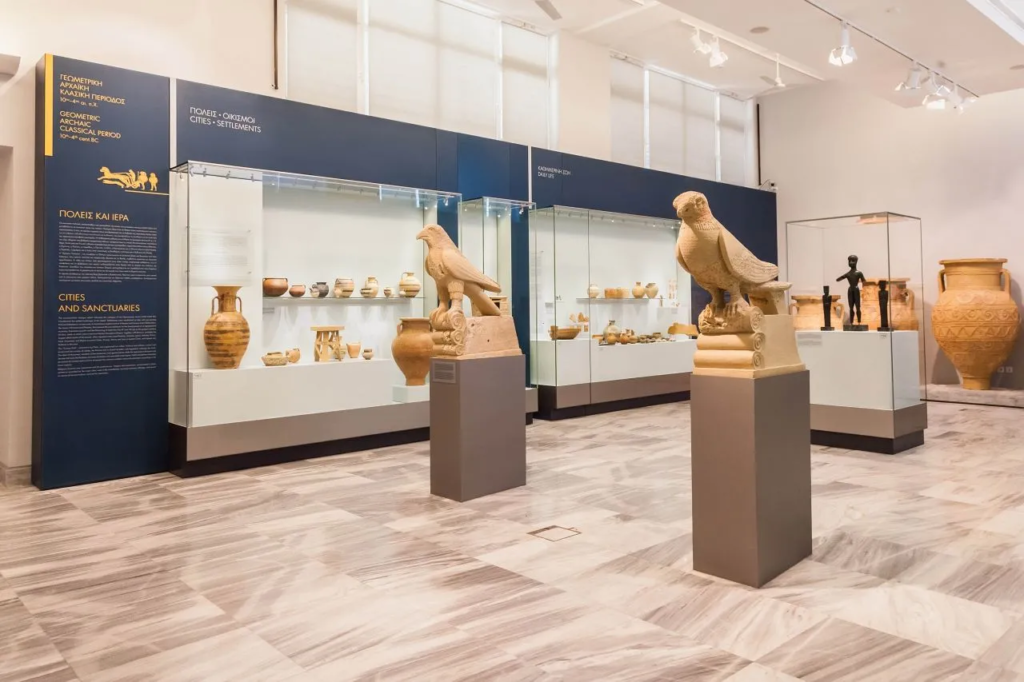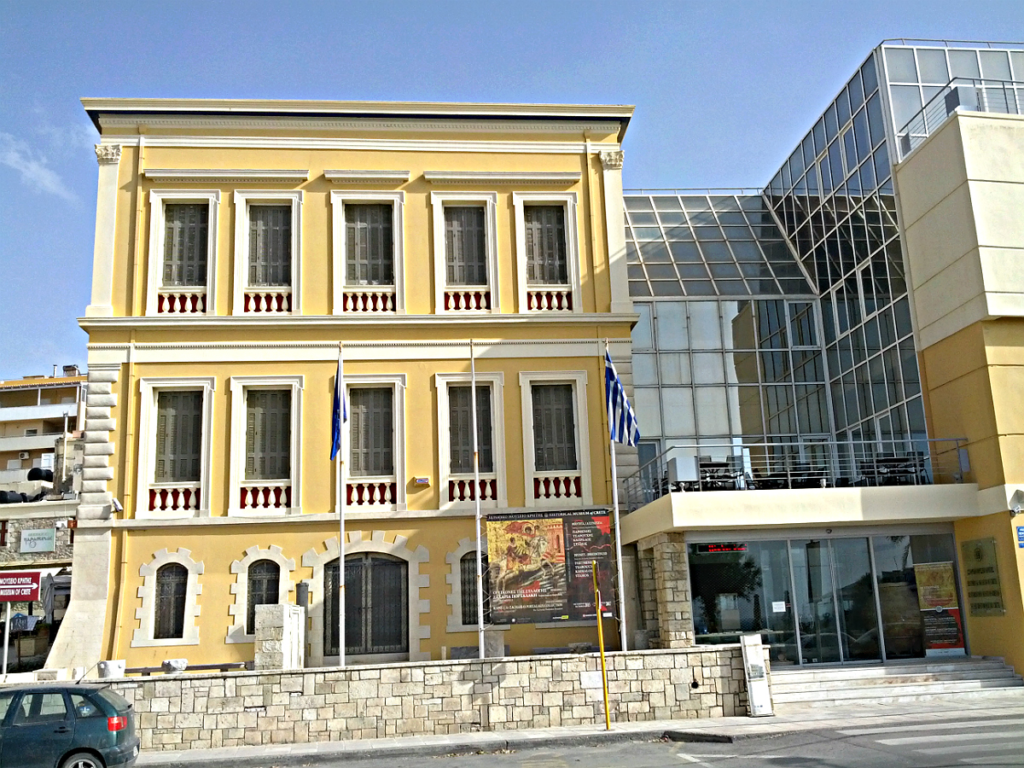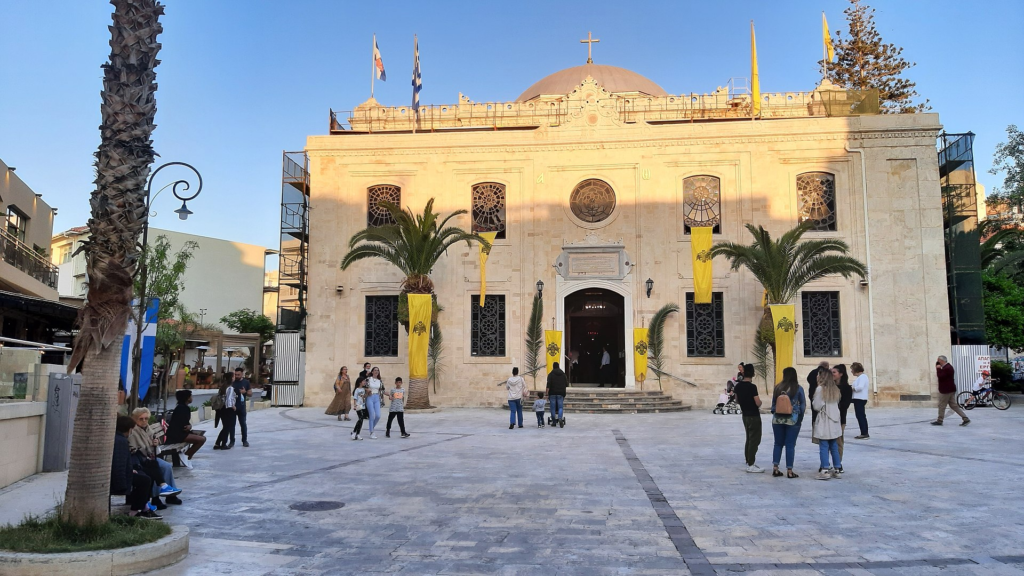Heraklion, the capital of Crete and the largest city on the island, is a bustling urban center with a rich history, vibrant culture, and stunning coastal views. As one of Greece’s major cities, Heraklion offers a mix of ancient ruins, medieval architecture, modern amenities, and lively nightlife. The city is famous for its archaeological treasures, especially the nearby Minoan palace of Knossos, as well as its charming old town and beautiful harbor. Here are some of the best places to visit in Heraklion, Greece:
Best Places to Visit
1. Knossos Palace

The Knossos Palace is the most famous archaeological site on Crete and one of the most significant in Greece. As the center of the Minoan civilization, the palace dates back to around 1900 BC and is associated with legends such as the Labyrinth and the Minotaur. The site features impressive ruins, including the grand staircase, the throne room, and vibrant frescoes. Visitors can explore the extensive complex and learn about the Minoan culture through guided tours and exhibits.
- Key Attractions: Minoan ruins, frescoes, throne room.
- Activities: Historical exploration, guided tours.
- Location: Knossos, Heraklion 714 09, Greece.
2. Heraklion Archaeological Museum

The Heraklion Archaeological Museum is one of the most important museums in Greece, housing an extensive collection of artifacts from the Minoan civilization and other ancient cultures of Crete. The museum’s exhibits include pottery, sculptures, jewelry, frescoes, and the famous Phaistos Disc. The collection provides a comprehensive overview of Cretan history from the Neolithic period to the Roman era. The museum’s well-curated displays offer a fascinating insight into the island’s rich cultural heritage.
- Key Attractions: Minoan artifacts, Phaistos Disc, frescoes.
- Activities: Museum visit, historical exploration.
- Location: Xanthoudidou 1, Heraklion 712 02, Greece.
3. Koules Fortress (Castello a Mare)

The Koules Fortress, also known as Castello a Mare, is a Venetian fortress located at the entrance of the old harbor of Heraklion. Built in the 16th century to protect the city from pirate attacks and invasions, the fortress offers a glimpse into the city’s maritime history. Visitors can explore the fortress’s thick walls, dungeons, and towers, and enjoy panoramic views of the harbor and the city. The fortress also hosts cultural events and exhibitions.
- Key Attractions: Venetian architecture, panoramic views, historical significance.
- Activities: Sightseeing, historical exploration.
- Location: Heraklion 712 02, Greece.
4. Heraklion Old Town and Venetian Walls

Heraklion’s Old Town is a charming area filled with narrow streets, historic buildings, and vibrant squares. The Venetian Walls, which date back to the 16th century, encircle the old town and are among the best-preserved city walls in Europe. Key attractions within the old town include the Morosini Fountain (also known as the Lions Fountain), the Loggia, and the Venetian Loggia. The area is also home to numerous shops, cafes, and restaurants, making it a lively and enjoyable place to explore.
- Key Attractions: Venetian Walls, Morosini Fountain, Loggia.
- Activities: Walking, shopping, dining.
- Location: Heraklion Old Town, Heraklion, Greece.
5. Cathedral of Saint Minas

The Cathedral of Saint Minas is the largest cathedral in Crete and an important religious site. Built in the late 19th century, the cathedral features impressive Byzantine-style architecture with a large dome, ornate frescoes, and beautiful iconography. The cathedral is dedicated to Saint Minas, the patron saint of Heraklion, and is an active place of worship. Visitors can admire the stunning interior and learn about the religious traditions of the city.
- Key Attractions: Byzantine architecture, frescoes, iconography.
- Activities: Religious exploration, sightseeing.
- Location: Agiou Mina 25, Heraklion 712 01, Greece.
6. Historical Museum of Crete

The Historical Museum of Crete is dedicated to the history and culture of Crete from the early Christian period to the modern era. The museum’s exhibits include religious artifacts, paintings, traditional costumes, and historical documents. Notable highlights include the works of the famous Cretan painter El Greco and the reconstruction of a traditional Cretan house. The museum offers a comprehensive overview of the island’s history and cultural evolution.
- Key Attractions: Religious artifacts, El Greco paintings, traditional costumes.
- Activities: Museum visit, cultural exploration.
- Location: Sofokli Venizelou Ave 27, Heraklion 712 02, Greece.
7. Agios Titos Church

Agios Titos Church is one of Heraklion’s oldest and most significant churches, dedicated to Saint Titus, the first bishop of Crete. The church was originally built in the 10th century and has undergone several renovations, reflecting the various architectural styles of the Byzantine, Venetian, and Ottoman periods. The church features a beautiful facade, intricate interior decorations, and a collection of religious icons. Agios Titos Church is an important religious and historical landmark in the city.
- Key Attractions: Byzantine architecture, religious icons, historical significance.
- Activities: Religious exploration, sightseeing.
- Location: 25 Avgoustou, Heraklion 712 02, Greece.
8. Natural History Museum of Crete

The Natural History Museum of Crete offers a fascinating exploration of the island’s natural environment and biodiversity. The museum features interactive exhibits, dioramas, and a range of specimens, including fossils, minerals, and native wildlife. The museum also has a large earthquake simulation platform, providing an educational and engaging experience for visitors. The museum’s focus on the natural history of Crete makes it a great destination for families and nature enthusiasts.
- Key Attractions: Interactive exhibits, native wildlife, earthquake simulation.
- Activities: Museum visit, educational exploration.
- Location: Sofokli Venizelou Ave 26, Heraklion 712 02, Greece.
9. Aquarium of Crete (Cretaquarium)

The Aquarium of Crete, also known as Cretaquarium, is one of the largest and most modern aquariums in Europe. Located just outside Heraklion, the aquarium features a wide variety of marine life, including sharks, rays, jellyfish, and colorful fish. The exhibits are designed to replicate the natural habitats of the Mediterranean Sea, providing an immersive experience for visitors. The aquarium is a great destination for families and those interested in marine biology.
- Key Attractions: Marine life, interactive exhibits.
- Activities: Aquarium visit, educational exploration.
- Location: Gournes, Heraklion 715 00, Greece.
10. Pankritio Stadium and Beach

Pankritio Stadium is a modern multi-purpose stadium located near the beach, just outside the city center. The stadium has hosted numerous sporting events, including football matches and athletic competitions. Next to the stadium is a beautiful sandy beach, offering a perfect spot for relaxation and water activities. The beach is equipped with sunbeds, umbrellas, and beach bars, making it a popular destination for locals and tourists alike.
- Key Attractions: Modern stadium, sandy beach, beach bars.
- Activities: Sunbathing, swimming, sports events.
- Location: Heraklion 713 03, Greece.
Summary Table
| Place | Description | Key Attraction | Location |
|---|---|---|---|
| Knossos Palace | Most famous archaeological site in Crete | Minoan ruins, frescoes | Knossos, Heraklion 714 09 |
| Heraklion Archaeological Museum | Extensive collection of Minoan artifacts | Phaistos Disc, frescoes | Xanthoudidou 1, Heraklion 712 02 |
| Koules Fortress | Venetian fortress at the old harbor | Venetian architecture, panoramic views | Heraklion 712 02 |
| Heraklion Old Town and Venetian Walls | Charming area with historic buildings | Venetian Walls, Morosini Fountain | Heraklion Old Town |
| Cathedral of Saint Minas | Largest cathedral in Crete | Byzantine architecture, frescoes | Agiou Mina 25, Heraklion 712 01 |
| Historical Museum of Crete | Museum covering Cretan history and culture | El Greco paintings, traditional costumes | Sofokli Venizelou Ave 27, Heraklion 712 02 |
| Agios Titos Church | Historic church dedicated to Saint Titus | Byzantine architecture, religious icons | 25 Avgoustou, Heraklion 712 02 |
| Natural History Museum of Crete | Interactive museum focused on natural history | Native wildlife, earthquake simulation | Sofokli Venizelou Ave 26, Heraklion 712 02 |
| Aquarium of Crete (Cretaquarium) | Modern aquarium showcasing Mediterranean marine life | Marine life, interactive exhibits | Gournes, Heraklion 715 00 |
| Pankritio Stadium and Beach | Modern stadium and nearby sandy beach | Sports events, sunbathing | Heraklion 713 03 |
How to Reach Heraklion
By Plane
Heraklion
International Airport “Nikos Kazantzakis” (HER) is the main airport serving the city, located about 5 kilometers east of the city center. The airport offers flights to and from major European cities. From the airport, visitors can reach the city center by taxi, bus, or rental car.
By Ferry
Heraklion has a busy port that connects the city to mainland Greece and other islands. Ferries operate regularly between Heraklion and Athens (Piraeus), as well as other Aegean islands. The port is located near the city center, making it a convenient option for travelers arriving by sea.
By Car
Heraklion is accessible by car via the E75 highway, which runs along the northern coast of Crete. The drive from Chania to Heraklion takes about 2 hours, while the drive from Rethymno takes about 1 hour. Visitors can rent a car or hire a private driver to explore the city and the island.
By Bus
Several bus companies operate routes to Heraklion from other cities in Crete, including Chania, Rethymno, and Agios Nikolaos. The main bus station, Heraklion Central Bus Station, is located near the port and city center, offering easy access to local transportation.
Best Time to Visit Heraklion
The best time to visit Heraklion is during the spring (April to June) and autumn (September to November) when the weather is mild and pleasant. These seasons are ideal for exploring the city’s outdoor attractions and enjoying cultural events. Summer (July to August) is also a popular time to visit, with warm temperatures and vibrant nightlife, although it can be busy with tourists. Winter (December to February) offers a quieter experience, with cooler temperatures and fewer crowds.
Travel Tips
- Local Cuisine: Heraklion is known for its delicious Cretan cuisine, including dishes like dakos (rusk salad), kalitsounia (cheese pies), and lamb with stamnagathi (wild greens). The city’s restaurants and tavernas offer a variety of traditional Cretan dishes and local specialties.
- Cultural Etiquette: The Cretans are known for their warm hospitality. It’s customary to greet people with a handshake or a kiss on both cheeks. When visiting religious sites or attending cultural events, dress modestly and be respectful.
- Transportation: Heraklion is a walkable city with most attractions located within the city center. The city also has a reliable public transportation system, including buses and taxis. Consider renting a bike or taking a guided tour to explore the city’s sights and nearby natural areas.
Itinerary Suggestions
One-Day Trip
- Morning: Start your day with a visit to Knossos Palace, followed by the Heraklion Archaeological Museum. Afterward, explore the Koules Fortress at the old harbor.
- Afternoon: Have lunch at a local taverna in Heraklion Old Town, then visit the Cathedral of Saint Minas and the Historical Museum of Crete. In the afternoon, explore Agios Titos Church and the Natural History Museum of Crete.
- Evening: Enjoy dinner at a restaurant along the waterfront, followed by a stroll through the vibrant old town and a visit to the Morosini Fountain.
Weekend Getaway
- Day 1: Begin with visits to Knossos Palace and the Heraklion Archaeological Museum. In the afternoon, explore the Koules Fortress and Heraklion Old Town. In the evening, dine at a local restaurant and experience Heraklion’s lively nightlife.
- Day 2: Start with a morning visit to the Aquarium of Crete (Cretaquarium) and the Pankritio Stadium and Beach. In the afternoon, explore the Historical Museum of Crete and Agios Titos Church. Conclude your trip with a relaxing evening at the Natural History Museum of Crete.
Heraklion’s rich history, stunning architecture, and vibrant culture make it a must-visit destination on the island of Crete. Whether you’re exploring its ancient ruins, savoring its local cuisine, or relaxing by the sea, Heraklion offers a unique and unforgettable experience for every traveler.





